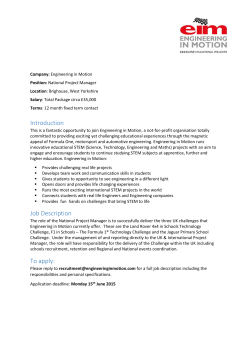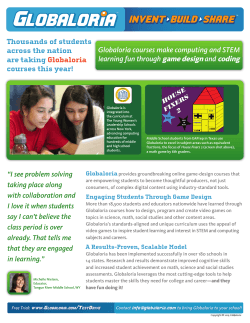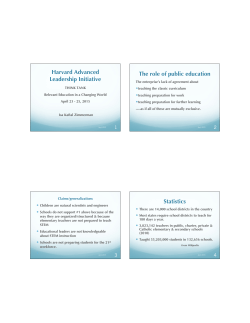
Activities
High Altitude Wind Power (HAWP) For a sustainable production of electricity from renewable source Low cost - Low environmental impact Strategic Business Plan 1/ 36 Copyright 2014 KiteGenVenture srl Table of contents Executive summary [1-4] The KiteGen® Technology [11-24] 1. 2. 1. 2. 3. 4. 5. 6. 7. 8. 9. 10. 11. Product history and strategic goals Team and corporate structure Demand / Energy Consumption Forecasts [5-6] 1. The “real” (energetic) cost of energy High Altitude Wind Power [6-10] 1. 2. 3. Competing Methodologies Overview of Players Status Geographical spread of main players The concept Development history KiteGen® Stem generator 3MW Main advantages Wind Farm configuration KiteGen® industrialization plan Current companies assets Prospect of KiteGen® technology development Onshore KiteGen® Carousel Offshore KiteGen® Carousel KiteGen® technology applications- K-Bus The KiteGen® Technology [25-30] 1. Comparison: KiteGen® and Conventional turbines Business development program [31-36] 1. 2. 3. 4. 2/ 36 Scenario with 8 KiteGen® Farms of size 33 MW New partners and investors evalutation for limited time Energy-intensive Industry International Development Copyright 2014 KiteGenVenture srl Product history and strategic goals Prototypes phase ended Industrialization phase of KITEGEN STEM 3 MW 2003. Project starting 2015 Continuous production test of Target design configuration 3MW output test Tropicalization design Complete machine test 2006. Ist prototype Mobile - 30kW nominal output Limited to low altitude experiments - Control system test Availability for existing partner’s initial orders 2007. IInd prototype Mobile - 30kW nominal output Altitude test up to 800mt Production cycle test - Cabling and generation test 2016 Wing and ropes design improvement - First farm and ancillary systems construction - Quantitative target based production 2010-2012. IIIth prototype 3MW nominal output - Stem configuration for wind gust management test - Duty cycle integration - Cut-in and cut-off testing Commercial availability 2017 CAPEX/OPEX optimization Software and management procedures update - Wing and ropes optimization - Increased Capacity Factor 3/ 36 Copyright 2014 KiteGenVenture srl Team and corporate structure Current status and future activities Kite Gen Research Srl Sequoia Automation Srl KiteGen Venture Srl 2009 in Turin (ITA) 1997 in Turin (ITA) 2011 in Turin (ITA) Limited company (LTD) Limited company (LTD) Limited company (LTD) Current Economic activity Granting exploitation rights of intellectual property and similar products Installation of instruments and appliances for measuring, checking, testing, navigating and other purposes (including industrial process control equipment) Future economic activities New IP delivery, IP maintenance and enforcement Research and development Industrialization Machines production Founded Legal status Management form BoD Holding company Business & Partnership development, Farm project planning execution and support, R&D funding Sole administrator + BoA Sole administrator BoD + MD M.Ippolito 1 auditor M. Ippolito M. Ippolito (President) D. Baratto (CEO) M. Boetti G. Abbate 4/ 36 Copyright 2014 KiteGenVenture srl The “real” (energetic) cost of energy The EROEI is defined as the Energy Return Over the Energy Invested ratio in a plant during its operational life (Picture 1). Oil, in the 1950's, had the highest EROEI ever recorded for any energy technology: roughly 100. In the 1970’s it had already dropped below the value of 40. Today it has decreased below the value of 10, and we can assume that it will continue to decrease. In other words, oil is finishing its “life cycle,” not because there is no more oil (and “by-products”) to extract, but because their energetic cost of extraction is increasing and therefore the EROEI is decreasing to values not sufficient to sustain growth and progress. 1950 Drillers would use one barrel to extract 100 barrels from the ground. 2010 5/ 36 Picture 1: ERoEI - Energy Return over Energy Investment Today, it takes about one barrel of oil to produce the equivalent of 8/9 barrels. Copyright 2014 KiteGenVenture srl High Altitude Wind Power HAWP Exploit even a small part of this huge resource can solve the global energy challenge. 6/ 36 Copyright 2014 KiteGenVenture srl Competing Methodologies Different approaches were explored starting from first experiments in 2000. Current projects can be classified using the following categories: 7/ 36 Ground gen HEAVY Fly gen LIGHTER 1. Fly/Ground generation: the power generation took place on the ground, with tethering cables that normally pull a drum rotation or directly on the flying element and later transferred to ground using a power cable 2. Heavy/Lighter than air: Flying elements can be wings such as kites or full airplanes. Airplanes normally integrate a fly generator used also as propeller for take-off, wings need other solutions Lighter can take-off without any help 3. Pumping/Continuous generation: Pumping involve a cycled production later described. Used in heavy/ground gen Continuous production is available in fly gen systems (or future ground gen) KiteGen Stem Makani Power Copyright 2014 KiteGenVenture srl Magenn Overview of Players status (1/2) KiteGen® and other most advanced HAWP projects Business Focus SkySails Germany Makani Power USA EnerKite Germany Ship traction using crosswind power / Traction power-kite with flying actuators Generator (propellers / turbines) on board” variant Tether cable and energy transfer to the ground Inflatable kite Traction power-kite with actuators and generators on a vehicle Status product already sold to pilot customers- 50kW prototype - 1MW prototype u.d.* Company structure impressive management team Established company recently shifted from flexible to rigid airfoils 30kW prototype CEO left the team in 2009 and company shrank from 40 to 15 people. 30kW prototype - 100KW prototype by 2015 core technical team left in 2009 to found new venture AmpyxPower Finance solid long term investment structure Financed by sponsors and local companies (port of Rotterdam) Ist round financing * u.d. = under development 8/ 36 Financed by google with 15 M$ since 2006 IInd round financing Copyright 2014 KiteGenVenture srl Overview of Players status (2/2) Business Focus Status Company structure Ampyx Power, Delft Netherland Plane Is building pumping wind generator with rigid airfoils 10kW prototype Founded by exmembers of TU Delft team Kite Power Netherland generator on board rigid airfoils Two different altitudes investigated 500-1000 m 10 000 m about 30 people based in Santa Cruz founded in 2009 by single investor JoeBen Bevirt (CEO) Ist round financing Guangdong Pumping Parachute Generators Generator on ground recently shifted from flexible to rigid airfoils - 30kW prototype - 1 MW generator envisaged CEO left the team in 2009 and company shrank from 40 to 15 people. First round financing Large wings, fully automatic system, ground generation floating platform in off-shore version - Industrialization of Stem 3 MW - the only player with a working MWsize prototype impressive management team - Strong partnership with multinational Financed by seed investors and subsidies until 2012 - Industrial plan financed HA WP China Kite Gen Italy Research 9/ 36 Finance Copyright 2014 KiteGenVenture srl Financed by seed investors and subsidies IInd round financing Geographical spread of main players MAIN PLAYERS: SOME INVESTORS: 10/ 36 Copyright 2014 KiteGenVenture srl The concept KiteGen® is the last evolution of wind energy exploitation: a radically new and innovative patented concept and system, with an estimated EROEI of 375, a value high enough to be the best "energy source" and most convenient technology known today to take advantage of high-altitude winds and produce clean energy without any CO2 emissions. The KiteGen® Technology is designed to provide an answer for the increasing need of energy production, proposing a NEW TYPE OF ELECTRIC GENERATION PLANT, based on a renewable source, suitable for any territory unlike the traditional wind turbines, at costs lower than fossil fuel generation plants, in direct competition with today’s conventional production (coal, oil or nuclear), and in the very near future in the GigaWatt class. In order to exploit this huge amount of energy a radical change of perspective has been done: 1. no more heavy and static structures, but lighter and more dynamic wind powered technology whose size is not affected by structural or dynamic limits as conventional turbines Today 2. but large wings, driven by a high-tech control system based on avionic sensors, fly at high altitude, harvesting the energy of powerful winds, much faster and constant than those available to traditional windmills. Very near future KiteGen® is a working reality largely competitive with any power generation systems, renewables and conventional, including nuclear energy, both in terms of power rating and cost of energy produced. 11/ 36 Copyright 2014 KiteGenVenture srl Mobile Pumping Kite Generators Pumping Kite Generators (KSU1 - Kite Steering Unit 1) (Stem 3 MW generator) Kite Gen was in pole position in the high altitude wind energy exploitation world contest March 2012, first flight and generation tests in Sommariva Perno (Italy) Mobilegen 1 (2006) Ist prototype 30kW nominal output Limited to low altitude experiments Control system test Mobilegen 2 (2007) IInd prototype 30kW nominal output Altitude test up to 800mt Production cycle test Cabling and generation test 12/ 36 Stem 3MW (2010-2012) IIIth prototype 3MW nominal output Stem configuration for wind gust management test Duty cycle integration Cut-in and cut-off testing Copyright 2014 KiteGenVenture srl PROTOTYPES PHASE ENDED Development history KiteGen Stem generator 3MW (1/5) The KiteGen Stem is an industrial robot that can independently manage the flight of a large wing. A tethered system, connected to ground station by two high tech specialized cables Power kites, giant semi-rigid air foils, with high aerodynamic efficiency, harness energy from the wind, whilst being automatically piloted. All the heavy machinery for power generation stays on the ground. To connect the two systems, high resistance lines transmit the kites’ traction and at the same time control their direction and angle to the wind. Power plants, with several units 13/ 36 A specialized semirigid wing with on-board sensors, flying at 300 km/h up to 9km height A unmanned «aerial vehicle», authomatically controlled in milliseconds from a ground based control system Copyright 2014 KiteGenVenture srl KiteGen Stem generator 3MW (2/5) » How it works The “KiteGen Stem generator” combines a very simple concept of energy production – that of the bicycle's dynamo generator - with an extremely advanced technology. KiteGen STEM transforms high-altitude wind energy into electricity, transmitting the force generated from the wing to a number of alternators located on the ground. Two highstrength cables transmit the traction of the wing and control direction and orientation. When the cables are fully unwound, the wing is guided to a position where it loses wind resistance and the cables are wound up. The energy consumed during this phase is equal to a fraction of the energy produced during the unwinding phase. The automatic kite flight control system, receiving data from on-board avionic sensors, autonomously pilots the power kites, so that their flight patterns can be controlled, synchronized and directed to maximize the production of energy. 14/ 36 KiteGen work phases. The wing flies from the height where cut-in wind speed is available (normally above 5-800mt, but max 9000 mt are possible), its trajectory loop is shaped as an horizontal «8», just like the kitesurfers do, and while rising up about 500mt from start height, the wing pulls the two ropes from the hearth of the machine (Active Phase). When the maximum height is reached the wing performs the side-slip manoeuvre (patented) that rewinds the two ropes (Passive Phase) with a minimum expenditure of energy from the one gathered in the active phase. Then the cycle restarts. Copyright 2014 KiteGenVenture srl KiteGen Stem generator 3MW (3/5) » Stem product design A. B. C. D. E. F. G. H. Power wing Dyneema® tethering Compass (optional) Stem Powered joints Ground structure Suspended and rotating engine room 2 power drums, 2 control pulleys, 8 motor-generator Structure description J K L I. J. K. L. cabinet and 6 actuators motorized joint drums motor drives and control 15/ 36 Power wing: Composite material flexible wing structure, 150mq Tethering: designed for 60 ton max traction, 20 ton working conditions Compass (optional) + Stem: gust control within few msec, dual cable control, 24 mt Ground structure: flexible for gust control, contain power generators, 13 x 6 mt d x h. Light Foundation to support ground structure and cable pull Drums: horizontal sliding to avoid cable accumulation, cooled, pulleys control tension Cabinet: inverter limiting power volatility supercapacitor used during wing recovery phase Motorized joint: gust power damping, take-off support, cable tension keeping Copyright 2014 KiteGenVenture srl KiteGen Stem generator 3MW (4/5) » Dimensions ~35 m (Dimensioni relative a KiteGen 03) 12.9 m 24 m ~34 m 6,2 m 16/ 36 Copyright 2014 KiteGenVenture srl Main advantages Production of great amounts of energy from renewable source and without CO2 emissions. A simple technology, but totally innovative and superior performances. . Production, throughout the year, of more than double the energy produced compared to a traditional wind turbine of similar size.. Higher availability of installation sites with lower impact. Greater energetic density per square kilometer of territory. PERFORMANCES A KiteGen STEM generator, with a power of 3 MW, provides up to 6.500 operating hours yearly at rated power (depending on the site’s features i.e. fly max height permit), ensuring very high ROI. The generator is reliable and suitable for any site, even if with little or no wind at ground level and difficult to access. The small size and reduced weight (less than 20 tonnes) makes the generator easy to carry and install. The simplicity of the machine and its robust construction ensure no degradation of performances over time. The only parts subject to wear are the cables and wings, consumable materials for the operation of the machine for a certain work time at rated power, after which they are replaced. 17/ 36 Copyright 2014 KiteGenVenture srl Wind Farm configuration KiteGen Stem generator in Wind farm configuration 5 The KiteGen® generator is a base module, suitable for solutions able to ensure a high scalability of the generation plant. “Wind Farm” configuration consists of a series of generators grouped together on a limited ground/sea space, in order to obtain greater energy production on a single limited site (Picture 1). This is possible both on sea and on the ground, with significant economies also from an organization and management point of view. Traditional windmills require spaces between the generators of on average 8-9 times the rotor’s diameter, in order to prevent generated turbulences from reducing efficiencies KiteGen® exploits a third dimension (the altitude) and, thanks to the electronic integrated control system, can divide the flying space in order to make the wings fly always on a unbiased front wind in a reduced territorial space. KiteGen ® generators can be placed 100 meters apart, thus enabling, on the same area required by traditional windmills, a nominal power production 4 times greater (Picture 2) 18/ 36 4 1 2 3 7 6 8 Picture 1: Wind farm configuration and grid connection 1. 2. 3. 4. 5. KiteGen® generator 3MW Static converter Short round trip accumulator Electric line VHV Flying Kite with radio datalink 6. 7. 8. Servo assisted take-off system (Energy needed <2kWh/launch) Bus DC 600V (1600A x Tower) KiteGen® wind farm Picture 2: Spatial distribution of KiteGen® Wind Farm Copyright 2014 KiteGenVenture srl KiteGen® industrialization plan State of art: Industrialization phase of KiteGen Stem 3 MW ongoing* 2014H1 2015H1 2017H1 Target design continuous production test Wing and ropes design improvement CAPEX/OPEX optimization Tests on the pre-industrial Power Wing First farm and ancillary systems construction Tropicalization design Software and management procedures update Initial tests on the complete machine Quantitative target based production in real conditions Wing and ropes optimization Availability for partner’s initial orders** Increased Capacity Factor TARGET LCOE: 23 €/MWh TARGET LCOE: 10 €/MWh * Source: Sequoia Automation Industrialization Plan ** Saudi Jubail CCU project. KiteGen® will be responsible for the concept and basic engineering, front end engineering design (FEED) and detailed engineering, procurement, construction (EPC) and future maintenance of the power facility. This project will be the renewable energy cornerstone of a Saudi 66 billion $ program aiming to power the region water desalinization. 19/ 36 Copyright 2014 KiteGenVenture srl KGV KRG - SEQUOIA Current companies assets 3000 international Patents Contract for Saudi Jubail CCU project Agreements with ENAC/ENAV and on-going contacts with EASA 17.000 sqm, Stem R&D and building site near Turin 2 € Mil equipment for R&D and pre-series building Award - Internationally evaluated business idea 22,68% share of Intellectual Property (KGR) International development and future holding Active partners in the banking, wind project development, transportation, project development, consulting, legal sector Award - Internationally evaluated business idea 20/ 36 Copyright 2014 KiteGenVenture srl Prospects of KiteGen® technology development KG Stem offshore KG Carousel KG Carousel Offsh. Objective: Carousel product development Objective: develop offshore version of Stem Activities: floating platform design, location definition, testing, control optimization Activities: whole design, prototyping, testing Activities: whole design, prototyping, testing Effort: 5y Effort: 5y Effort: 2y Result: new product sales Result: new product sales, power up GW Result: new product sales, power up GW 21/ 36 Objective: Carousel product development K-Bus E-mobility Objective: EMobility Activities: whole design, prototyping, testing Effort: 1y Result: new product sales Copyright 2014 KiteGenVenture srl Onshore KiteGen Carousel TECHNOLOGY PLANNED DEVELOPMENT Objective: Carousel product development Activities: whole design, prototyping, testing Effort: 5y Result: new product sales, power up GW Status: concept Costs: 0,5 €Mil/MW PBT: 8y Value prop: greater scalability, high power NASA Langley Research Center “Wind Energy Airborne Harvesting System Study” density, even lower LCOE awtdata.webs.com 22/ 36 Copyright 2014 KiteGenVenture srl Offshore KiteGen Carousel TECHNOLOGY PLANNED DEVELOPMENT Objective: Carousel product development Activities: whole design, prototyping, testing Effort: 5y Result: new product sales, power up GW Status: concept Costs: 0,5 €Mil/MW PBT: 8y Value prop: greater scalability, high power density, even lower LCOE NASA Langley Research Center “Wind Energy Airborne Harvesting System Study” awtdata.webs.com 23/ 36 Copyright 2014 KiteGenVenture srl KiteGen® technology enabled applications » K-Bus E-mobility – Patented ultrafast recharge system A new collective mobility paradigm, solving battery life limits Present design and status. Specific or standard bus with internal supercapacitor energy storage, electric engine, able to recharge in 5 sec on a specialized ground station, and to travel up to 2 km. Strong patents granted in EU, USA, Canada. 24/ 36 Copyright 2014 KiteGenVenture srl Comparison: KiteGen® and Conventional turbines » Overview of relevant factors Among other factors, the relevant ones are dimensions, masses, logistics, disposal, environmental impact, capacity factor, territorial energy density, site properties, levelized costs of energy, intermittence and EROEI, as shown in the table below: KiteGen Stem Wind turbines 6800* 1700 20 2000 Min. distance between generators (m.) 100 1000 (9 x blade diameter) Average ground machine height (m.) 30 150 3 MW 3 MW 300 4 <20** 90-150 Equivalent working hours at nominal power Weight including fundations (tons) Nominal power Territorial energy density (average, MW/kmq) Produced energy cost (€/MWh, Italy) * Advanced Tecnological Learning Curve, ** Advanced Economical Learning Curve; 25/ 36 Copyright 2014 KiteGenVenture srl Comparison: KiteGen® and Conventional turbines » Dimensions Vestas V90 3MW ~150 m Duomo of Milan ~108 m But high altitude wind remains out of the reach of current and the future’s aerogenerating towers, already more than 100m high. Above a certain height the structure that holds up the rotors becomes exponentially heavier, more unstable, and above all more costly The relatively higher wind availability at lower altitudes at open sea still does not make traditional windmills economically feasible. The high thrust and moment generated by the windmill on the platform during operations require heavy, complex (and costly) platform and mooring systems in deep water. KiteGen Stem 3MW ~34 m 26/ 36 Copyright 2014 KiteGenVenture srl Comparison: KiteGen® and Conventional turbines » Masses Conventional turbine Rotors ~41 ton KiteGen Stem 3MW The small size and reduced weight makes the generator easy to carry and install. Nacelle ~70 ton Foundation ~1500 ton Igloo + Stem ~12 ton Tower ~ 285 ton Foundation < 10 ton TOT < 20 ton TOT ~ 2000 ton 27/ 36 Copyright 2014 KiteGenVenture srl Comparison: KiteGen® and Conventional turbines » Logistics, assembly and decommissioning KiteGen Stem 3MW Conventional turbine 28/ 36 No component with a weight exceeding 120 kg Shipment in 3 containers 40" It does not require special equipment for assembly Easily removable and installation site easily restorable (use of micro-piles for foundations) Copyright 2014 KiteGenVenture srl Comparison: KiteGen® and Conventional turbines » Environmental impact and major benefits of our offer Modest visual impact of the generator Virtually no visual impact of cables and wings (no shadow projected) Low noise to the ground, no reduction systems alternators Low noise of wings and cables in relation to the working distance Reduced impact on the ground (use of micropiles) and limited use of the same No infrastructural work required for transport and assembly No emission of CO2 or other gases Negligible impact with birds (normally under the operational portion of the wing) 29/ 36 Copyright 2014 KiteGenVenture srl Comparison: KiteGen® and Conventional turbines » Territorial energy density 121 KiteGen STEM x 3MW density: (363 MW)/Kmq 6 Conventional Turbines x 3 MW density: 18 MW/Kmq) 1000 m 1000 m 30/ 36 Copyright 2014 KiteGenVenture srl Comparison: KiteGen® and Conventional turbines » Territorial energy density 121 KiteGen STEM x 3MW density: 363 MW/Kmq 6 Conventional Turbines x 3 MW density: 18 MW/Kmq 31/ 36 Copyright 2014 KiteGenVenture srl Business Development Program Strategies Exploit even a small part of this huge resource can solve the global energy challenge. 32/ 36 Copyright 2014 KiteGenVenture srl Scenario with 8 KiteGen farms of size 33 MW KGV 51% Partners 49% NEWCO 33/ 36 Copyright 2014 KiteGenVenture srl Opportunity of Investment in KiteGen Venture KGV 51% 9% 34/36 Copyright 2014 KiteGenVenture srl Energy–Intensive Industries Industry Energy Consumption ie: above 10 MW (~1M$/year) Cost of Energy from Energy KGV 51% 9% Profit KiteGen Farm of 33MW 10 MW 33 Free 10 MW 35/ 36 Copyright 2014 KiteGenVenture srl 23 International Development KGV 51% 36/ 36 Copyright 2014 KiteGenVenture srl KiteGen® Technology Business Development Management KiteGenVenture Srl Corso Lombardia, 63/c 10099 San Mauro Torinese (TO) Italy Email: info@kitegenventure.com www.kitegenventure.com Tel. 011 3747510 Awards - Internationally evaluated business idea We strongly believe that the exploitation of this resource can be the solution that everyone is awaiting, in order to mitigate, if not cancel, our dependence on fossil fuels while drastically reduce the emission of greenhouse gases.
© Copyright 2025









